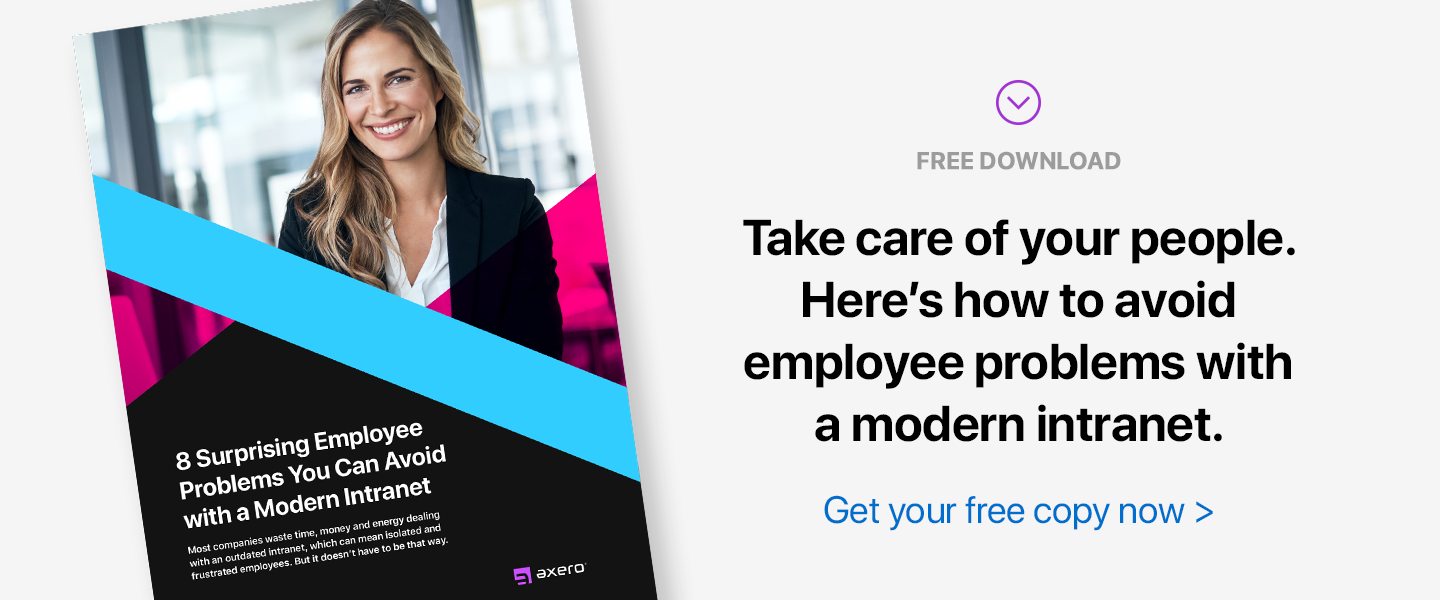Getting more users to create content on our chat forum by starting discussions.
— Moderator
Who doesn’t like to chat? Complain about your problems. Brilliantly solve them for other people. Confirm your superior knowledge. (“Hey, I just did this… Does anyone have a better idea?”) Get inside info and timely advice. You know there’s a ton of chatting going on in your company right now. You try to channel it into your brand new intranet, and… radio silence.
Every selling point and beneficial feature of your intranet relies on the fact that your people, well, use it. Social intranet is a creature of high-performing cultures, where employees seek out information and advice, have high self-esteem, and are not afraid to look foolish in front of one another. Today, any company can find an intranet platform that fits its size and work style. However, you may need to adjust your culture to make your intranet a success.
Don’t worry. It’s not a big deal. The shift toward social has been happening in society at large, and it’s doubtful that your employees have been left behind. They just need time to bring their social networking skills—minus some annoying social networking habits—to work.
Of course, you want it to happen sooner rather than later. And you’re wondering how you can help your employees along. I am going to suggest a few strategies that came from a trusted source: intranet customers like you. But first, I need to know a little about your employees.
First, what kind of platform did you use in the past? Are you switching from another social intranet brand? Upgrading from a static intranet? Or did you not have an intranet at all, and this is the first time that inside-the-company information is posted online?
Your employees’ attitudes toward your new system come from the habits and expectations they have formed in the recent past. If they have any prior intranet experience, it’s important to explain how the new system is similar or different from the old one.
Coming from another social intranet platform
Nobody abandons a well-functioning system to try new things or save a few bucks. The most common reason companies switch to a new platform is utter frustration with the old one.
A prolonged battle with your intranet software can sour your employees on the entire product category. A new customer once told me he’d heard his IT guy call Axero “jazzed up SharePoint.” Axero is about as similar to SharePoint as Axero—a small privately held company focused on a single product—is to Microsoft. However, if your greatest fear in life is to get stuck with SharePoint, you might see it in the least likely places.
The only way to overcome this fear is by training. Show your people how easy it is to start online discussions. Many of our customers use training videos to introduce the most important features and get people started. We are creating a library of fifty to sixty bite-size how-to videos they can store on the intranet or drip-email to their employees.
Coming from a static intranet
If your employees have never posted on the intranet, they will have more questions than “how do I use a discussion forum?” They will want to know what kinds of questions are appropriate, who should answer them, and what happens if they make a mistake.
To model the correct use of the forums, some customers seed them with questions and answers. If you suspect that your people are intimidated by the intranet, you could get them started with a few dumb questions, the kind that will lower expectations and put people at ease.
Ask the managers to post questions and encourage everyone on the team to respond. Explain that responses need not be perfect. Once a thread gets started, other people will chime in to correct and complete the original answer. You might even slip in a few intentional errors to move your resident know-it-alls to action.
Coming from no intranet
Employees with no intranet experience could be easier to train than the ones who have only used a static intranet. At least, they won’t treat it as read-only. That’s why I cringe when a prospective buyer decides to save money and put in a static intranet “to start with.” Digital technology gets obsolete too fast as it is. Why give yourself an extra disadvantage from the get-go?
Intranet habits aside, you must know where your employees currently get answers to the questions you want them to discuss online. Do they ask their managers? Coworkers? Internal experts? Do they Google them?
Ask the people who frequently get questions from other employees to redirect them to the discussions forums. The simplest way to do this is to send the employee who asked, a link to the appropriate forum and have him type it in. This way, he’ll get the most accurate, complete, and up-to-date information and save his coworkers time and effort of asking and answering the same question again.
Make this a standard practice with folks who get bombarded with questions: HR, IT help desk, project managers, top execs, and so on. This will help your employees to get into a habit of asking a group rather than a specific individual.
Talking to a big group may be counterintuitive at first since email uses the opposite rule of thumb: include as few recipients as possible. However, once your employees see how online discussions work at your company, self-censorship will change accordingly.
Finally, don’t expect everyone to participate equally. It is typical for only a small percentage of employees to start discussions. Another fraction will answer and comment, while a large number might lurk, consuming the content created by other people. (For more on lurking, see Chapter 6, Network, in Who the Hell Wants to Work for You?)
Unless yours is a small, tightly knit organization, some lurking—or even a lot of lurking—is okay. One of our customers interviewed employees who didn’t seem to use the intranet at all. She found that these employees logged in regularly and were just as informed as those who posted and commented.
(One exception to the lurking rule is management. Managers should never be lurking. At least not until rank-and-file employees feel empowered to take charge of the forums. See How to Get Managers to Use Your New Intranet for more advice.)
_____
If you want to empower your employees, you might like my book, because empowerment and engagement are the same.
If you want your employees to start more online discussions, you might like our intranet software, because it helps employees communicate better.













 info@axerosolutions.com
info@axerosolutions.com 1-855-AXERO-55
1-855-AXERO-55


